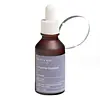What's inside
What's inside
 Key Ingredients
Key Ingredients

 Benefits
Benefits

 Concerns
Concerns

No concerns
 Ingredients Side-by-side
Ingredients Side-by-side

Water
Skin ConditioningPropylene Glycol
HumectantCaprylic/Capric Triglyceride
MaskingIsopropyl Myristate
EmollientPolysorbate 80
EmulsifyingSodium Dna
Skin ConditioningNiacinamide
SmoothingButylene Glycol
HumectantCeteareth-6 Olivate
EmulsifyingCyclopentasiloxane
Emollient1,2-Hexanediol
Skin ConditioningCetyl PEG/PPG-10/1 Dimethicone
EmulsifyingAcetyl Hexapeptide-8
HumectantPentapeptide-18
Skin ConditioningOligopeptide-91 Rh-Oligopeptide-1
Skin ConditioningAdenosine
Skin ConditioningPanthenol
Skin ConditioningHyaluronic Acid
HumectantSqualane
EmollientAnemarrhena Asphodeloides Root Extract
Skin ConditioningCeramide NP
Skin ConditioningCetearyl Olivate
Sorbitan Olivate
EmulsifyingTrehalose
HumectantCaprylyl Glycol
EmollientHydrogenated Lecithin
EmulsifyingLauryl Glucoside
CleansingSodium Chloride
MaskingCellulose Gum
Emulsion StabilisingLactic Acid
BufferingEthylhexylglycerin
Skin ConditioningHydrogenated Polyisobutene
EmollientGlycerin
HumectantSodium Bicarbonate
AbrasiveSodium Carbonate
BufferingCitric Acid
BufferingWater, Propylene Glycol, Caprylic/Capric Triglyceride, Isopropyl Myristate, Polysorbate 80, Sodium Dna, Niacinamide, Butylene Glycol, Ceteareth-6 Olivate, Cyclopentasiloxane, 1,2-Hexanediol, Cetyl PEG/PPG-10/1 Dimethicone, Acetyl Hexapeptide-8, Pentapeptide-18, Oligopeptide-91 Rh-Oligopeptide-1, Adenosine, Panthenol, Hyaluronic Acid, Squalane, Anemarrhena Asphodeloides Root Extract, Ceramide NP, Cetearyl Olivate, Sorbitan Olivate, Trehalose, Caprylyl Glycol, Hydrogenated Lecithin, Lauryl Glucoside, Sodium Chloride, Cellulose Gum, Lactic Acid, Ethylhexylglycerin, Hydrogenated Polyisobutene, Glycerin, Sodium Bicarbonate, Sodium Carbonate, Citric Acid
Water
Skin ConditioningGlycereth-26
Humectant1,2-Hexanediol
Skin ConditioningButylene Glycol
HumectantGlycerin
HumectantArginine
MaskingCarbomer
Emulsion StabilisingEthylhexylglycerin
Skin ConditioningPolyglyceryl-10 Laurate
Skin ConditioningAdenosine
Skin ConditioningCaprylyl Glycol
EmollientCopper Tripeptide-1
Skin ConditioningHexapeptide-11
Skin ConditioningHexapeptide-9
Skin ConditioningPalmitoyl Pentapeptide-4
Skin ConditioningPalmitoyl Tripeptide-1
Skin ConditioningTripeptide-1
Skin Conditioning
 Reviews
Reviews

Ingredients Explained
These ingredients are found in both products.
Ingredients higher up in an ingredient list are typically present in a larger amount.
1,2-Hexanediol is a synthetic liquid and another multi-functional powerhouse.
It is a:
- Humectant, drawing moisture into the skin
- Emollient, helping to soften skin
- Solvent, dispersing and stabilizing formulas
- Preservative booster, enhancing the antimicrobial activity of other preservatives
Adenosine is in every living organism. It is one of four components in nucleic acids that helps store our DNA.
Adenosine has many benefits when used. These benefits include hydrating the skin, smoothing skin, and reducing wrinkles. Once applied, adenosine increases collagen production. It also helps with improving firmness and tissue repair.
Studies have found adenosine may also help with wound healing.
In skincare products, Adenosine is usually derived from yeast.
Learn more about AdenosineButylene Glycol (or BG) is used within cosmetic products for a few different reasons:
Overall, Butylene Glycol is a safe and well-rounded ingredient that works well with other ingredients.
Though this ingredient works well with most skin types, some people with sensitive skin may experience a reaction such as allergic rashes, closed comedones, or itchiness.
Learn more about Butylene GlycolCaprylyl Glycol is a humectant and emollient, meaning it attracts and preserves moisture.
It is a common ingredient in many products, especially those designed to hydrate skin. The primary benefits are retaining moisture, skin softening, and promoting a healthy skin barrier.
Though Caprylyl Glycol is an alcohol derived from fatty acids, it is not the kind that can dry out skin.
This ingredient is also used as a preservative to extend the life of products. It has slight antimicrobial properties.
Learn more about Caprylyl GlycolEthylhexylglycerin (we can't pronounce this either) is commonly used as a preservative and skin softener. It is derived from glyceryl.
You might see Ethylhexylglycerin often paired with other preservatives such as phenoxyethanol. Ethylhexylglycerin has been found to increase the effectiveness of these other preservatives.
Glycerin is already naturally found in your skin. It helps moisturize and protect your skin.
A study from 2016 found glycerin to be more effective as a humectant than AHAs and hyaluronic acid.
As a humectant, it helps the skin stay hydrated by pulling moisture to your skin. The low molecular weight of glycerin allows it to pull moisture into the deeper layers of your skin.
Hydrated skin improves your skin barrier; Your skin barrier helps protect against irritants and bacteria.
Glycerin has also been found to have antimicrobial and antiviral properties. Due to these properties, glycerin is often used in wound and burn treatments.
In cosmetics, glycerin is usually derived from plants such as soybean or palm. However, it can also be sourced from animals, such as tallow or animal fat.
This ingredient is organic, colorless, odorless, and non-toxic.
Glycerin is the name for this ingredient in American English. British English uses Glycerol/Glycerine.
Learn more about GlycerinWater. It's the most common cosmetic ingredient of all. You'll usually see it at the top of ingredient lists, meaning that it makes up the largest part of the product.
So why is it so popular? Water most often acts as a solvent - this means that it helps dissolve other ingredients into the formulation.
You'll also recognize water as that liquid we all need to stay alive. If you see this, drink a glass of water. Stay hydrated!
Learn more about Water